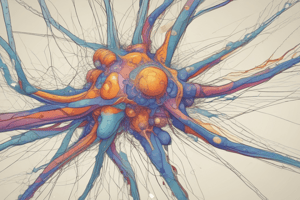Podcast
Questions and Answers
What are the two primary aspects of functional requirements identified and modeled in the previous chapters?
What are the two primary aspects of functional requirements identified and modeled in the previous chapters?
- Post conditions and exceptions conditions
- Stakeholders and preconditions
- Activity diagrams and SSD notation
- Use cases and domain classes (correct)
What do fully developed use case descriptions provide information about?
What do fully developed use case descriptions provide information about?
- Domain classes and internal processing
- Stakeholders, preconditions, post conditions, the flow of activities, and exceptions conditions (correct)
- Activity diagrams, SSD notation, and CRUD integration
- Inputs, outputs, and system sequence diagrams
When is a brief use case description typically used?
When is a brief use case description typically used?
- For complex applications with multiple scenarios and exception conditions
- For very simple, well-understood applications with few exception conditions (correct)
- For domain classes and internal processing
- For integrating requirements models
What does a brief use case description not document?
What does a brief use case description not document?
What can activity diagrams be used to show?
What can activity diagrams be used to show?
What is the focus of detail modeling for use cases in the chapter?
What is the focus of detail modeling for use cases in the chapter?
What are the two primary aspects of functional requirements modeled in the previous chapters?
What are the two primary aspects of functional requirements modeled in the previous chapters?
What does a fully developed use case description provide information about?
What does a fully developed use case description provide information about?
When is a brief use case description typically used?
When is a brief use case description typically used?
What does a brief use case description not document?
What does a brief use case description not document?
What can activity diagrams be used to show?
What can activity diagrams be used to show?
What is the focus of detail modeling for use cases in the chapter?
What is the focus of detail modeling for use cases in the chapter?
What is the purpose of brief use case descriptions?
What is the purpose of brief use case descriptions?
What is included in typical use case description templates?
What is included in typical use case description templates?
What is the format for use case name?
What is the format for use case name?
Who are the actors in use case descriptions?
Who are the actors in use case descriptions?
What do preconditions and postconditions detail?
What do preconditions and postconditions detail?
What do activity diagrams document?
What do activity diagrams document?
What do UML activity diagrams provide?
What do UML activity diagrams provide?
When are fully developed use case descriptions essential?
When are fully developed use case descriptions essential?
What do fully developed use case descriptions provide?
What do fully developed use case descriptions provide?
What are activity diagrams effective in illustrating?
What are activity diagrams effective in illustrating?
What is the focus of the chapter on Systems Analysis and Design?
What is the focus of the chapter on Systems Analysis and Design?
Flashcards are hidden until you start studying
Study Notes
Use Case Descriptions and Activity Diagrams in Systems Analysis and Design
- Brief use case descriptions are suitable for simple projects, quick overviews, agile development, and prototyping.
- Fully developed use case descriptions are essential for complex projects, large teams, detailed testing, and regulatory compliance.
- Typical use case description templates include use case name, scenario, triggering event, brief description, actors, related use cases, stakeholders, preconditions, postconditions, flow of activities, and exception conditions.
- Use case name follows a verb-noun format and can have multiple scenarios.
- Actors are users identified from use case diagrams, and stakeholders are those with an interest in the use case.
- Preconditions and postconditions detail the conditions before and after the use case is completed, and flow of activities illustrates user-system interactions.
- Exception conditions outline potential errors and issues.
- Activity diagrams are used to document user workflows and model processing, particularly for complex use cases.
- UML activity diagrams provide a visual representation of the flow of activities for specific use cases.
- Fully developed use case descriptions and activity diagrams provide detailed information about use cases, including actors, stakeholders, preconditions, postconditions, flow of activities, and exception conditions.
- Activity diagrams are effective in illustrating the flow of activities within a use case, especially in complex scenarios.
- The chapter focuses on providing detailed models of use cases, including fully developed use case descriptions and activity diagrams, to understand user interactions with the system.
Studying That Suits You
Use AI to generate personalized quizzes and flashcards to suit your learning preferences.



